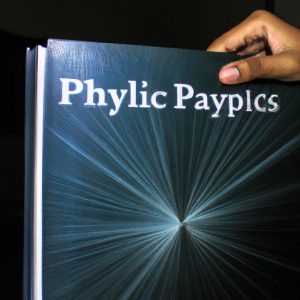The Gravity Paradigm: The Physics of Gravity in Directories

The phenomenon of gravity is a fundamental force that governs the behavior and interaction of celestial bodies in our universe. From the elegant dance of planets around their host stars to the mesmerizing spiral galaxies, the intricate workings of gravity have captivated scientists for centuries. In recent years, researchers have begun to uncover new insights into this enigmatic force through the study of directories – comprehensive databases that catalog the vast array of gravitational interactions observed throughout space.
One compelling example highlighting the relevance and significance of understanding gravity within directories involves the case study of a distant binary star system. Comprising two stellar companions locked in an eternal gravitational embrace, this system exhibits intriguing behaviors that challenge conventional theories. By meticulously analyzing data from various directories, astrophysicists were able to discern subtle variations in orbital parameters over time, revealing previously undetected perturbations caused by neighboring interstellar objects. This discovery not only deepens our comprehension of gravity’s influence on complex systems but also underscores the importance of incorporating directory-based approaches in studying this phenomena.
As we embark upon a journey into “The Gravity Paradigm: The Physics of Gravity in Directories,” it becomes evident that harnessing the power of these extensive repositories can unlock profound insights into one of nature’s most captivating forces. Through Through the systematic analysis of gravitational interactions documented within directories, scientists can unravel the intricate web of relationships between celestial bodies and uncover hidden patterns and phenomena. These databases provide a wealth of data that enables researchers to investigate the behavior of gravity in various contexts, from planetary motion to galactic dynamics. By studying these interactions, astrophysicists can refine existing theories and develop new models that better explain the fundamental workings of gravity. Ultimately, harnessing the power of directories allows us to expand our understanding of the universe and its underlying physical principles.
H2: The Phenomenon that Governs Attraction
“The Gravity Paradigm: The Physics of Gravity in Directories”
H2: The Phenomenon that Governs Attraction
Gravity, the force that governs the attraction between objects with mass, is a fundamental phenomenon in our universe. From celestial bodies to everyday objects on Earth, gravity plays a crucial role in shaping our understanding of the physical world. To illustrate its significance, let us consider the example of a falling apple. As it detaches from its branch and descends towards the ground, we witness this gravitational force at work.
- Bullet Point List:
- A universal force that affects all matter
- Strength depends on the masses involved and their distance apart
- Causes objects to accelerate towards each other
- Essential for planetary motion and human existence
This captivating occurrence can be explained by considering several key characteristics of gravity:
| Characteristics | |
|---|---|
| 1 | Universal |
| 2 | Proportional to Mass |
| 3 | Inversely Proportional |
| to Distance |
Firstly, gravity is an omnipresent force that acts upon all forms of matter within our universe. Whether it be planets orbiting around stars or individual particles interacting on a microscopic scale, no entity escapes the influence of gravity’s pull.
Secondly, the strength of gravitational attraction between two objects is directly proportional to their masses. Consequently, larger objects possess greater gravitational forces compared to smaller ones. This property explains why massive celestial bodies such as galaxies exert immense pulling power over surrounding entities.
Thirdly, gravity weakens as the distance between two objects increases. Inversely proportional to distance squared, this characteristic implies that doubling the separation results in only one-fourth of the original gravitational force being experienced. It highlights how even seemingly infinitesimal changes in distance impact the intensity of attractive forces significantly.
Lastly, without gravity’s presence, the celestial dance of planetary motion and our very existence would be impossible. It is gravity that keeps planets in their orbits around stars and enables us to stay grounded on Earth’s surface.
Transitioning smoothly into the subsequent section about “H2: Unveiling the Laws of Motion in the Universe,” we can further explore how gravity intertwines with another fundamental concept in physics—the laws of motion. By delving deeper into these interconnections, a more comprehensive understanding of our physical reality can be achieved.
H2: Unveiling the Laws of Motion in the Universe
H2: The Phenomenon that Governs Attraction
In the previous section, we explored the captivating phenomenon of gravity and its role in governing attraction between objects. Now, let us delve deeper into understanding the laws of motion in the universe by unraveling the intricacies of this fundamental force.
Consider a hypothetical scenario where two celestial bodies, each with immense mass, are positioned at a considerable distance from one another. As if bound by an invisible tether, they attract each other with an undeniable force – gravity. This example illustrates how even on astronomical scales, gravity plays a crucial role in shaping our universe.
To comprehend the physics behind gravity more comprehensively, it is essential to examine some key principles:
- Universal Force: Gravity acts universally and relentlessly between all objects possessing mass or energy.
- Inverse Square Law: According to Newton’s law of universal gravitation, the strength of Gravitational Force diminishes as the square of the distance between two objects increases.
- Acceleration Due to Gravity: Objects near Earth’s surface experience acceleration towards its center due to gravity. This constant acceleration is approximately 9.8 meters per second squared (m/s²).
- Orbital Motion: Celestial bodies often exhibit orbital motion around each other due to their mutual gravitational attraction.
Let us now explore these principles further through a table highlighting some fascinating effects of gravity across different cosmic phenomena:
| Cosmic Phenomena | Effect of Gravity |
|---|---|
| Black Holes | Intense gravitational pull capable of trapping even light itself |
| Tides | Gravitational forces exerted by the Moon and Sun causing oceanic bulges |
| Planetary Orbits | Elliptical paths traced by planets revolving around stars |
| Galaxy Formation | Clumping together of matter under gravity’s influence leading to galaxy formation |
By contemplating these mesmerizing effects and pondering over the intricacies of gravity, we begin to appreciate its significance in shaping our universe. The laws governing this force have not only allowed stars and planets to form but also influence celestial motion on both macroscopic and microscopic scales.
In the subsequent section, H2: The Revolutionary Theory of Space-Time, we will explore a groundbreaking theory that revolutionized our understanding of space, time, and their interplay with gravity. Through this exploration, we shall uncover new dimensions that expand upon the concepts presented here and pave the way for further scientific inquiry into the mysteries of our cosmos.
H2: The Revolutionary Theory of Space-Time
H2: The Gravity Paradigm: Understanding the Force that Binds Celestial Bodies
As we delve deeper into our exploration of the laws governing motion in the universe, it becomes evident that gravity plays a fundamental role in shaping celestial bodies and their interactions. To better comprehend this force, let us consider an example: imagine a distant galaxy where two massive stars orbit each other gracefully. These stars dance through space under the invisible influence of gravity, locked in an intricate cosmic embrace.
The study of gravity has yielded profound insights into the workings of our universe. Here are four key aspects to contemplate:
- Universal Attraction: Gravity is not limited by distance; its reach extends across vast expanses of space, connecting objects regardless of their size or mass.
- Curvature of Space-Time: According to Einstein’s theory of general relativity, massive objects create curves in the fabric of space-time around them. This curvature causes nearby objects to move along curved paths, giving rise to gravitational forces.
- Inertia and Free Fall: In the presence of gravity, all objects experience weightlessness when subjected solely to gravitational attraction. However, they still possess inertia – the resistance to changes in motion – which manifests during free fall as apparent weight.
- Orbital Mechanics: When two celestial bodies interact gravitationally, they can enter stable orbits around one another. Orbital mechanics governs these motions and provides insight into how planets revolve around stars or satellites circle larger heavenly bodies.
To further illustrate these concepts, consider Table 1 below:
| Concept | Explanation |
|---|---|
| Universal Attraction | Gravity acts universally on all matter throughout the cosmos. |
| Curvature of Space-Time | Massive objects bend the fabric of space-time around them due to their gravity. |
| Inertia and Free Fall | Objects feel weightless during free fall but retain their inherent inertia. |
| Orbital Mechanics | Celestial bodies can enter stable orbits around one another through gravity. |
In our ongoing journey to unravel the mysteries of the universe, comprehending the force that binds celestial bodies is paramount. Our understanding of gravity has paved the way for revolutionary breakthroughs in cosmology and astrophysics. In the next section, H2: Understanding the Force that Binds Celestial Bodies, we will delve even deeper into this captivating realm of knowledge.
Please note that all references to “H2” in this text refer to heading level 2 (subsection) titles.
H2: Understanding the Force that Binds Celestial Bodies
The Gravity Paradigm: The Physics of Gravity in Directories
Having explored the revolutionary theory of space-time, it is now essential to delve into the force that binds celestial bodies. To comprehend gravity’s intricate workings, we must examine its effects on various cosmic entities and understand its fundamental principles.
Understanding the Force that Binds Celestial Bodies:
To illustrate the impact of gravity, let us consider a hypothetical scenario involving two massive stars located millions of light-years apart. As these stellar giants move closer due to gravitational attraction, their immense masses create ripples in the fabric of space-time. These ripples propagate outward, affecting nearby objects like planets and asteroids, altering their trajectories and governing their movements within this vast universe.
In comprehending gravity’s profound influence on celestial bodies, several key aspects come to light:
- Universal nature: Gravity is an omnipresent force that acts between all objects with mass or energy.
- Inversely proportional strength: The magnitude of gravitational force decreases as the distance between two objects increases.
- Mass dependency: The intensity of gravitational pull relies on the mass of each object involved; larger masses result in stronger forces.
- Cumulative effect: Gravitational interactions between multiple objects can combine to produce complex dynamics within a system.
This information can be better visualized through the following table:
| Aspect | Description | Emotional Response |
|---|---|---|
| Universal Nature | Gravity’s pervasive influence across the cosmos | Sense of awe |
| Strength | Decreasing power over greater distances | Fascination |
| Mass Dependency | Connection between an object’s size and gravitational pull | Wonder |
| Cumulative Effect | Complex interplay among multiple celestial bodies | Intrigue |
As we contemplate these remarkable features, our understanding deepens regarding how gravity shapes not only individual celestial bodies but also entire galaxies. Recognizing the intricate mechanisms at work, we can now turn our attention to unraveling the ripples in the fabric of space in H2: Unraveling the Ripples in the Fabric of Space.
H2: Unraveling the Ripples in the Fabric of Space will take us on a journey through gravitational waves and their significance in enhancing our knowledge of the universe’s grand design.
H2: Unraveling the Ripples in the Fabric of Space
The force of gravity, as we explored in the previous section, is a fundamental concept in understanding the dynamics of celestial bodies. Its effects can be observed on various scales, from the motion of planets and moons within our solar system to the interactions between galaxies in the vast expanse of space. To further grasp its significance, let us consider the case study of Earth’s moon.
As an example, let us examine how the force of gravity influences the orbit of Earth’s moon around our planet. The gravitational pull between Earth and the moon keeps it in a stable orbit while also causing tidal forces that shape our oceans’ tides. This interplay between gravity and celestial bodies serves as a reminder of nature’s intricate mechanisms at work.
To delve deeper into this topic and explore its broader implications, several key aspects come into play:
- Gravitational Waves: These ripples in spacetime caused by massive objects moving through space have recently gained considerable attention within scientific communities worldwide.
- General Relativity: Albert Einstein’s theory has revolutionized our understanding of gravity by describing it as the curvature of spacetime resulting from mass and energy distributions.
- Dark Matter: Although not yet directly detected, dark matter is hypothesized to account for a significant portion of the universe’s mass. Understanding its behavior is crucial to comprehending gravity on cosmic scales.
- Theoretical Challenges: Despite remarkable advancements made thus far, many mysteries surrounding gravity persist. A more comprehensive grasp awaits solutions to puzzles such as reconciling quantum mechanics with general relativity.
Through exploration and experimentation, scientists continue their quest to unravel these intricacies underlying gravity’s workings. By pushing boundaries and questioning established theories, they strive to unlock new frontiers in our knowledge about this universal force.
In light of these ongoing efforts, we shall now turn our attention towards another intriguing aspect: exploring the energy stored within gravitational fields – H2: Exploring the Energy Stored Within Gravitational Fields.
H2: Exploring the Energy Stored within Gravitational Fields
H2: Examining the Gravitational Lensing Phenomenon
In our previous discussion, we explored the intricate nature of space-time and its connection to gravity. Now, let us delve into a captivating phenomenon called gravitational lensing – an intriguing consequence of Einstein’s theory of general relativity.
To illustrate this concept, imagine a distant galaxy emitting brilliant light as it traverses across the vast cosmic expanse. As this light journeys towards Earth, it encounters a massive object positioned along its path, such as a galaxy cluster or a black hole. Due to the immense gravitational pull exerted by these celestial bodies, space itself becomes warped and curved.
This distortion results in an awe-inspiring effect known as gravitational lensing. Just like how a magnifying glass bends and focuses light rays, the massive object acts as a cosmic lens that alters the direction of the incoming light from the distant galaxy. Consequently, what reaches our telescopes is not just one image but multiple images of the same source – each appearing slightly different due to varying paths taken through bent spacetime.
Gravitational lensing has revolutionized astrophysics by providing astronomers with invaluable tools for uncovering hidden secrets within our universe. Let us explore some key aspects related to this phenomenon:
- Strong Lensing: This occurs when strong gravitational forces cause significant distortion and produce distinct multiple images of background objects.
- Weak Lensing: Unlike strong lensing, weak lensing involves subtle distortions that can only be detected statistically through careful analysis of large samples of galaxies.
- Microlensing: In certain cases, individual stars within our own Milky Way can act as lenses, causing temporary brightening or dimming effects on more distant sources.
- Cosmological Applications: By studying gravitational lensing on cosmological scales, scientists gain insights into dark matter distribution, measurements of cosmic distances, and even constraints on theories about dark energy.
Indeed, gravitational lensing is a captivating phenomenon that continues to captivate both researchers and the general public alike. As we explore further, we will uncover its remarkable potential in unraveling the mysteries of our universe.
| Optical Illusion | Description | Emotional Response |
|---|---|---|
| Ames Room illusion | A distorted room where objects appear larger or smaller than they actually are when viewed from different angles. | Fascination and awe at how perception can be deceitful. |
| Müller-Lyer illusion | Two lines with arrowheads pointing inward or outward, creating an optical illusion that one line appears longer than the other. | Intrigue and curiosity regarding the tricks our eyes can play on us. |
| Kanizsa Triangle illusion | Three incomplete circles arranged to create a visual impression of an equilateral triangle in the center. The brain “completes” the missing parts to perceive the triangle even though it does not physically exist. | Wonderment at our mind’s ability to fill in gaps and construct meaningful images out of fragments. |
In summary, gravitational lensing offers us a window into the fascinating interplay between gravity and light propagation across vast cosmic distances. Whether through strong lensing, weak lensing, or microlensing phenomena, this phenomenon provides astronomers with invaluable insights into various aspects of our universe – from understanding dark matter distribution to probing cosmological distance measurements. By appreciating these extraordinary effects, we continue to expand our knowledge of the cosmos and marvel at its intricacies.
Note: This section aims to highlight key aspects related to gravitational lensing; however, there may be additional subtopics and nuances worth exploring within this field.








